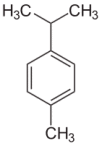Update on Monoterpenes as Antimicrobial Agents: A Particular Focus on p-Cymene
- PMID: 28809799
- PMCID: PMC5578313
- DOI: 10.3390/ma10080947
Update on Monoterpenes as Antimicrobial Agents: A Particular Focus on p-Cymene
Abstract
p-Cymene [1-methyl-4-(1-methylethyl)-benzene] is a monoterpene found in over 100 plant species used for medicine and food purposes. It shows a range of biological activity including antioxidant, anti-inflammatory, antinociceptive, anxiolytic, anticancer and antimicrobial effects. This last property has been widely investigated due to the urgent need for new substances with antimicrobial properties, to be used to treat communicable diseases whose diffusion in developed countries has been facilitated by globalization and the evolution of antimicrobial resistance. This review summarizes available scientific data, as reported by the most recent studies describing the antimicrobial activity of p-cymene either alone, or as the main component of plant extracts, as well as addressing the mechanisms of action of cymenes as antimicrobial agents. While p-cymene is one of the major constituents of extracts and essential oils used in traditional medicines as antimicrobial agents, but considering the limited data on its in vivo efficacy and safety, further studies are required to reach a definitive recommendation on the use and beneficial effects of p-cymene in human healthcare and in biomedical applications as a promising candidate to functionalize biomaterials and nanomaterials.
Keywords: antibacterial; antimicrobial; cymenes; monoterpenes.
Conflict of interest statement
The authors declare no conflict of interest.
Figures
References
-
- Crozier A., Clifford M.N., Ashihara H. Plant Secondary Metabolites: Occurrence, Structure and Role in the Human Diet. Blackwell Publishing Ltd.; Oxford, UK: 2006.
Publication types
LinkOut - more resources
Full Text Sources
Other Literature Sources


